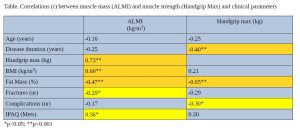Background: Structural, metabolic, and functional signs of skeletal muscle damage have been identified in individuals affected by type 1 diabetes (T1D), but, to our knowledge, no guidelines for the diagnosis and treatment of muscle impairment exist and studies on T1D and muscle health remain limited. Aims: The aim of this study was to evaluate the prevalence of sarcopenia in a long-term T1D population and to assess the effects of some clinical parameters on muscle mass and function. Methods: Forty-eight patients affected by T1D were enrolled. Body mass index (BMI), body composition- appendicular lean mass index (ALMI) and fat mass (FM), and muscle strength were measured and information about diabetes related complications and number of fractures in anamnesis were collected. Additionally, the physical activity level was assessed using the International Physical Activity Questionnaire (IPAQ). To establish the diagnosis of sarcopenia, the diagnostic criteria of the Writing Group for the European Working Group on Sarcopenia in Older People 2 (EWGSOP2) were used. Results: In the present sample (mean age 50.00±13.02y, 46% women, mean duration of diabetes 29.77±11.18y), the prevalence of sarcopenia was 6.25% (9.09% in women and 3.84% in men). The prevalence of low ALMI was 25% (27% in women and 23% in men). Significant inverse correlations were found between ALMI and FM and ALMI and fractures; and significant positive correlations between ALMI and BMI, physical activity level, and muscle strength. At the same time, significant inverse correlations were observed between muscle strength and duration of diabetes, FM and the presence of diabetes related complications (table).

Conclusions: We observed a high prevalence of low muscle mass, similar to those found in the older age groups of the general population (25 years in advance) and our findings suggest a possible pathogenetic role of T1D duration on muscle trophism and function.

